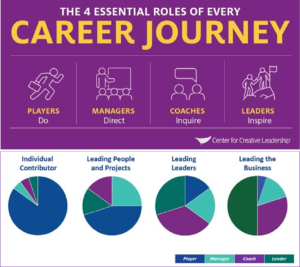BY: Center for Creative Leadership
Every role we play as humans has certain responsibilities and skills that come with it. And as we all know, each of us plays multiple roles.
In our personal lives, this usually feels natural. We may play the roles of both parent and child, sibling, friend, and more. We lean on what we’ve seen from our upbringing and what we learn from our culture, peers, and partners. Generally, we know which role to play in which situations.
But what about professional lives? Very often, we have a professional qualification or specific area of expertise – engineer, accountant, project manager, doctor, teacher, etc. As our careers progress, we often add or change titles – Specialist, Manager, Leader, Director, Vice President, etc. We have a job description and things to be achieved in the role.
Our work with leaders across the globe over half a century has led us to a seemingly simple, but crucial insight: we must play multiple roles in our professional lives, irrespective of our qualifications or industry. And perhaps the roles most crucial for our long term success are not those on job descriptions, but those needed to make leadership happen in our organizations. The key comes in our ability to play each role, and to choose the right role for the right situation.

There are 4 leadership roles that every professional must navigate and draw upon to be successful:
- Player
- Manager
- Coach
- Leader
PLAYER – Players are individual contributors who are vital to achieving the goals of an organization. They are the “doers” who create value by making the product or providing the service.
Regardless of our formal role, all of us keep the Player in the mix of roles we need to play to contribute to our organizations. Any time we are focused on our own performance and getting things done ourselves, we are in the player role. Even in the C-suite, there are times where it’s important to “just do it.”
MANAGER – When you manage people or projects, you need to learn to step back from doing all of the work yourself. A manager is the one responsible for organizing the work, driving efficiency, holding people accountable, and helping get problems solved. Like the Player, the Manager is focused on performance, but they need to get things done through others. This is all about the mindset shift that we like to call going “from Me to We.” And it’s one of the hardest ones a professional has to make throughout their leadership career.
COACH – While we all know what an individual contributor is, and many of us carry a title with the word manager, the Coach role is just as critical when we want to enable leadership across individuals and teams. While the Player and Manager roles are focused on performance, the Coach is focused on development.
The Coach role is not about solving the problems, it’s about helping people get out of their own way so they can become better problem solvers. Coaches are trying to bring the best out in people, trying to get people to activate their strengths. They listen, ask powerful questions, and help grow capabilities over time.
LEADER – Management is about doing things right, but leadership is about doing the right thing.
Regardless of job title, when you act in the Leader role, you see the big picture and connect the dots – for yourself and others. Like the Coach, the Leader is about development overtime. But they are not just developing individual capabilities, they are looking at the whole system.
They are influencing others and taking actions to develop the collective capacity for direction, alignment, and commitment (DAC). At CCL, we know that when there’s shared DAC, leadership is happening.
WHEN TO PLAY EACH OF THESE LEADERSHIP ROLES At every stage of your career, you’ll be required to play each of these leadership roles, but what we tend to see is that the ideal ratio changes as you move through different levels of leadership. As we’ve worked with leaders around the globe, we’ve found that there are some predictable shifts in the amount of time you’ll need to spend in each role in order to be most successful.
While the ideal ratio varies a little from one industry to another, and from more matrixed organizations to more traditional ones, what we tend to see looks like the chart above.
Pause for a moment to consider your current professional responsibilities.
- How do you currently divide your time between these 4 leadership roles?
- How comfortable and capable do you feel in each role?
- What role might you need to play more or less frequently to be even more successful?
You can also learn more by watching our webinar on The 4 Leadership Roles Successful Managers Must Play.
Since 1970, The Center for Creative Leadership (CCL®) has been committed to delivering results that matter through leadership solutions customized to clients’ needs. CCL helps its clients to grow by accelerating their leadership performance, their knowledge and partnerships drive sustained results for clients, and committed to create a better world through our work in the social sector. More resources available at www.ccl.org.



